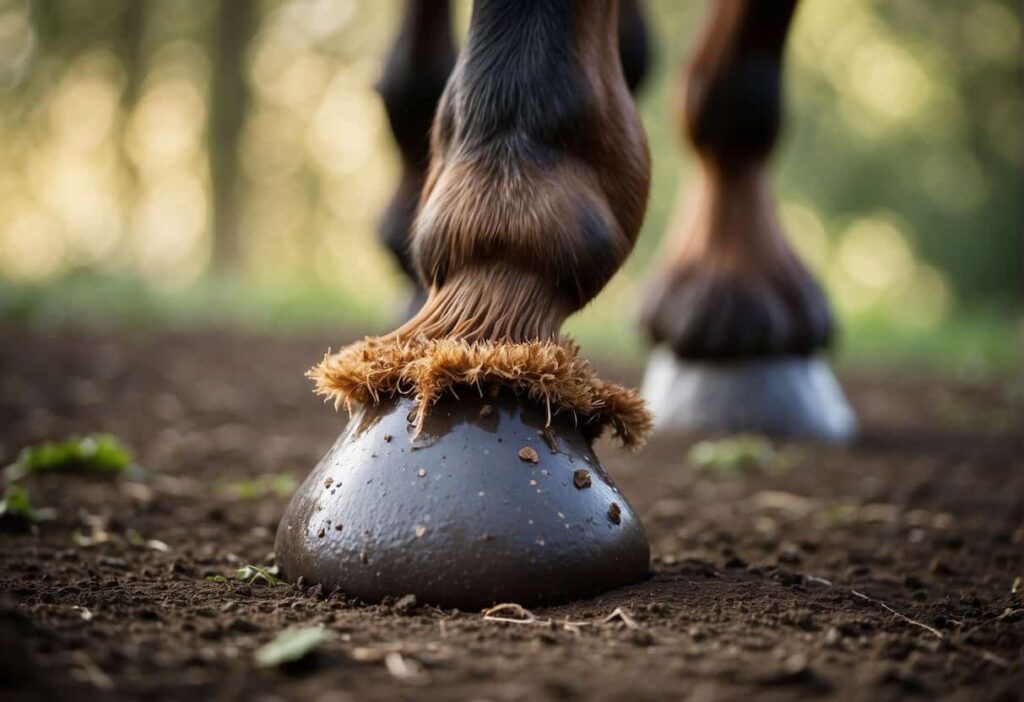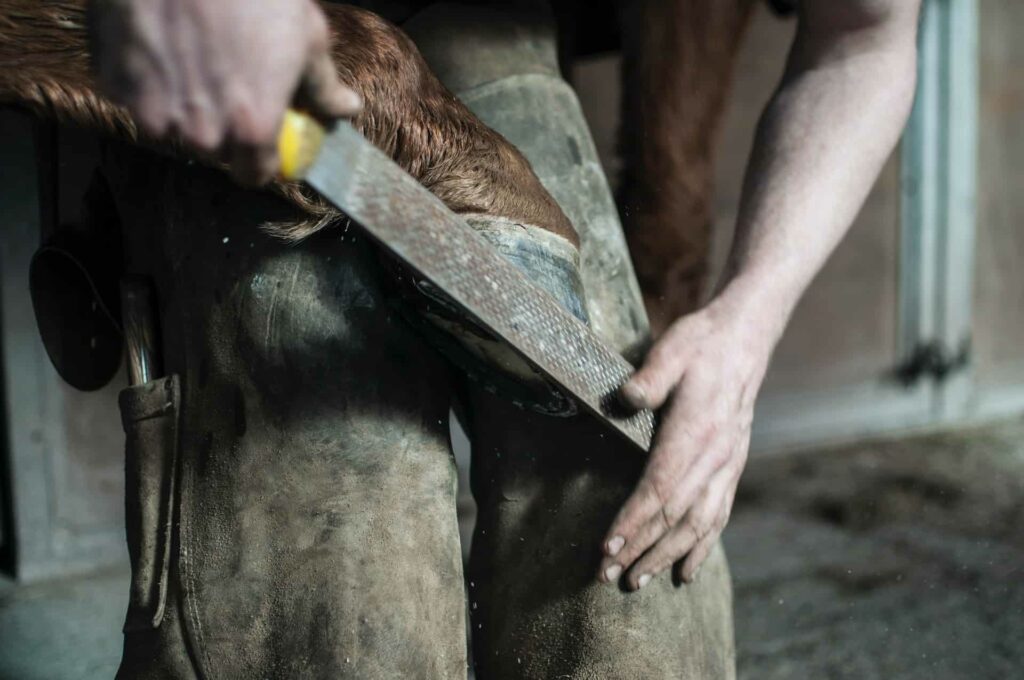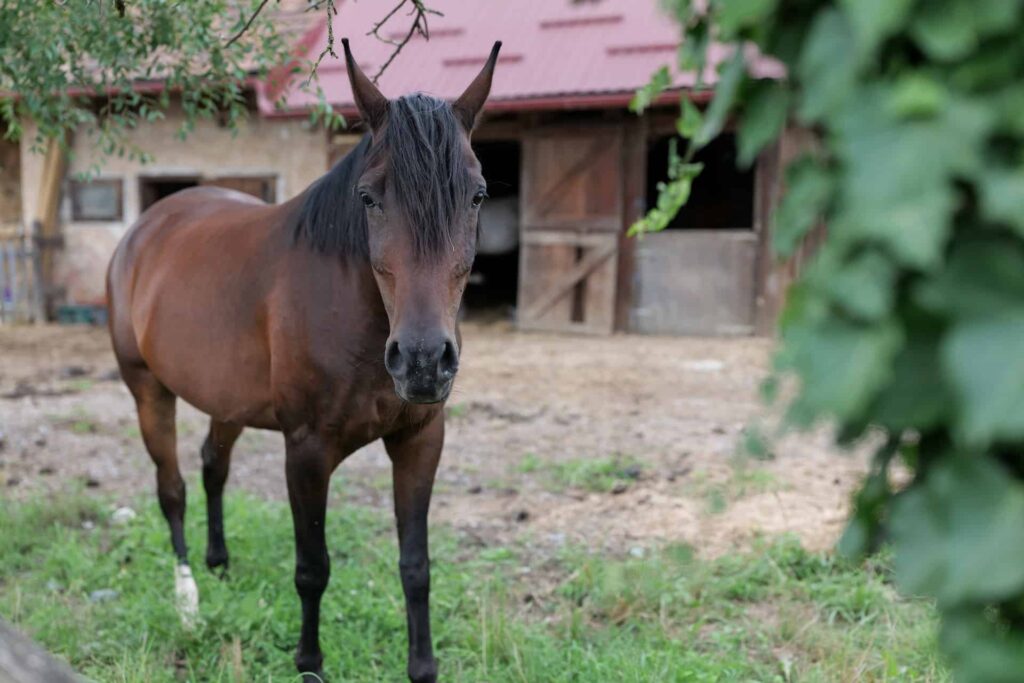Thrush in horses is an infection of the hoof characterized by a foul odor and a black, tar-like discharge, primarily affecting the frog which is a V-shaped structure on the bottom of the hoof. Caused by anaerobic bacteria and sometimes compounded by fungal organisms, thrush thrives in moist, dirty environments which compromise the health of the horse’s hooves. The condition can cause discomfort and lameness if not addressed in a timely fashion, making it a significant concern for horse owners and caretakers.
Effective management and prevention of thrush entail maintaining clean, dry stabling conditions, regular hoof care by a professional farrier, and appropriate hygiene practices. Treatment typically involves the removal of necrotic tissue and the application of commercial antiseptic agents to the affected areas. Understanding the environmental factors and anatomy involved in equine thrush is paramount in both treatment and prevention strategies. With attentive care, thrush can be resolved, although recurrence is common if conditions are not improved.
Key Takeaways
- Thrush is an infectious hoof disease in horses, often characterized by a distinct odor and discharge.
- Prevention focuses on hygiene and environmental management, including regular hoof cleaning and proper stable conditions.
- Treatment requires removal of diseased tissue and the use of antiseptic products, with vigilance to prevent reoccurrence.
Understanding Thrush
Thrush in horses is a common hoof condition characterized by a black, tar-like discharge with a foul smell. Horse owners need to recognize the signs of thrush and understand its causes for effective prevention and treatment.
What is Thrush?
Thrush is an infection of the horse’s hoof, primarily affecting the frog, which is the softer, triangle-shaped part located between the heels. It is caused by anaerobic bacteria and sometimes fungi that thrive in moist, dirty, and low-oxygen environments. When a hoof is affected by thrush, it can emit a distinctive foul smell and exhibit a dark discharge.
Causes of Thrush
The development of thrush in horses can be attributed to several factors, including:
- Poor Hygiene: A dirty or muddy stable can increase the risk of thrush.
- Inadequate Hoof Care: Infrequent hoof cleaning or trimming contributes to thrush development.
- Moist Environments: Prolonged exposure to wet conditions can create a breeding ground for the bacteria and fungi leading to thrush.
- Lack of Air Circulation: Poorly ventilated hooves, due to conditions such as overgrown hoof walls and frogs, can promote the growth of anaerobic organisms.
Studies have suggested that pasturing can decrease the prevalence of thrush, highlighting the importance of good management practices.
Identifying Thrush in Horses
To identify thrush in horses, owners, and caretakers should look for:
- A black or dark-colored discharge from the frog.
- A foul odor emanates from the affected hoof.
- Tenderness or sensitivity in the horse’s hoof when the frog is pressed.
If any of these signs are present, it is advisable to consult a veterinarian or a qualified farrier who can confirm the diagnosis and recommend the appropriate treatment. In most cases, treatment involves cleaning the infected area and applying topical antiseptic agents to combat the bacterial and fungal infection. Proper hoof care and stable maintenance are pivotal in preventing thrush.
Anatomy of the Hoof

The anatomy of the horse’s hoof is intricate, consisting of several structures that are vital for their well-being and mobility. Understanding this anatomy is crucial, especially in the context of hoof diseases such as thrush.
Hoof Structure
The hoof of a horse is a complex structure consisting of the outer horn, a tough and protective layer, and the internal sensitive structures that support the weight of the horse. Structurally, it can be compared to a human fingernail, but much thicker and weight-bearing. The hoof wall is divided into three sections: toe, quarters, and heels. The internal area beneath the hoof wall houses sensitive tissue and provides the necessary nutrients and support for the hoof’s growth and strength.
The Role of Frog
The frog acts as a shock absorber and aids in the circulation of blood within the hoof. It is the triangular, rubbery portion of the hoof’s underside, fitting between the heels and extending halfway toward the front of the hoof. When a horse puts weight on its hoof, the frog compresses, helping to pump blood back up the leg. This structure is susceptible to thrush, and its health is indicative of overall hoof condition.
Sulci and Fissures
The central sulcus is a cleft in the middle of the frog, while the lateral and collateral sulci are the grooves that run along the sides of the frog. These grooves can trap mud, feces, and other debris, creating an anaerobic environment that can foster the growth of bacteria and lead to infections like thrush. Moreover, these sulci are integral in maintaining balance and grip as the horse moves, as well as in the overall structural integrity of the hoof.
Prevention Strategies
In combating thrush in horses, three key elements are pivotal: maintaining a clean and dry environment, practicing diligent hoof care, and ensuring balanced nutrition and regular exercise.
Environmental Control
Controlling a horse’s environment plays a crucial role in preventing thrush. Stables should be kept clean and dry, as thrush bacteria thrive in damp, dirty conditions. Bedding should be regularly replaced to minimize moisture and manure buildup. Moreover, providing a dry place for the horse when outside of the stable can reduce the risk of hoof infection.
Daily Hoof Care
Daily cleaning of the hooves is essential to prevent thrush. Each hoof should be picked out to remove debris, and the use of a hoof brush can assist in clearing out any trapped mud or manure. Regular trimming by a farrier can also prevent conditions conducive to thrush development.
Proper Nutrition and Exercise
A balanced diet ensures that hooves are healthy and resistant to infections such as thrush. Supplements rich in biotin can be beneficial for hoof strength. Daily exercise is important not only for overall health but also for promoting good circulation in the hooves, which is key in preventing thrush.
Treatment and Management
Effective treatment and management of thrush in horses incorporate immediate action, diligent monitoring, and professional assistance, ensuring the best possible outcome and preventing complications such as lameness or pain.
Initial Treatment Steps
Thrush Buster: When thrush is detected, the use of specialized treatments like Thrush Buster could be key. It is vital to initiate targeted therapy to halt the progression of the infection.
Clean and Dry Environment: Consistently keeping the affected hooves clean and in a dry environment prevents further bacterial growth.
Daily Hoof Care: An essential first step in addressing thrush includes daily hoof care with cleaning, which often involves the use of disinfectants like iodine, bleach solutions, or hydrogen peroxide to target and kill the bacteria.
Ongoing Care and Monitoring
Regular Trimming and Debridement: Periodic trimming by a farrier is crucial for removing necrotic tissue and encouraging healthy hoof growth. If necessary, debridement may be performed to excise diseased tissue.
Daily Inspections: Owners should continue with daily inspections and cleaning. Moisture levels around the hoof should be regularly assessed and managed to maintain a conducive environment for healing.
Working with Professionals
Veterinarian and Farrier Collaboration: A cooperative approach involving a veterinarian and a farrier can optimize treatment strategies. They can provide expert insights into the specific case and emphasize a custom treatment plan.
Monitoring for Signs of Pain or Lameness: Professionals help in the early detection of complications such as lameness or pain, adjusting the prognosis and treatment plan accordingly to address these issues. They can recommend systemic therapies if the infection is severe or persistent.

Common Challenges and Solutions
Dealing with thrush in horses often involves managing recurring infections, addressing severe cases, and striving for hoof integrity. Effective management relies on understanding the role of anaerobic bacteria like Fusobacterium necrophorum in causing the condition, the importance of oxygen exposure, and maintaining the overall health of the hoof.
Recurring Infections
Persistent issues with thrush can lead to deep pockets in the hoof and necrotic tissue, which are ideal conditions for bacterial infection to thrive. To manage recurring infections:
- Rotate Pastures: Preventing exposure to wet environments helps reduce the anaerobic conditions favorable for bacterial growth.
- Daily Hoof Cleaning: Removing debris and ensuring hooves are clean disrupts infection cycles.
Dealing with Severe Cases
In severe cases of thrush, the horse may become lame or develop deep fissures within the hoof that harbor infection. Methods to address severe thrush include:
- Topical Treatments: Applying commercial antimicrobials can help to reduce the bacterial load.
- Professional Care: A veterinarian or farrier may need to remove necrotic tissue and advise on targeted treatments.
Maintaining Hoof Integrity
The integrity of the hoof is crucial for preventing thrush and other conditions like white-line disease. To support hoof integrity:
- Balanced Diet: Nutrition plays a role in maintaining strong hooves capable of resisting infections.
- Regular Trimming: Keeping hooves trimmed prevents fissures and uneven wear that can lead to problems.
By following these practices, horse owners can reduce the incidence of thrush and promote the ongoing health of their horse’s hooves.
Supplementary Care and Products
Effective management of thrush in horses relies on both targeted treatments and supplementary care to ensure the infection is addressed and overall hoof health is maintained.
Supportive Therapies
Environment Management: It is crucial to keep the horse’s living area dry and clean as thrush thrives in wet conditions. This involves daily stall cleanings and providing a dry turnout area to reduce exposure to moisture which can exacerbate the condition.
Proper Hoof Care: Regular trimming and maintenance by a skilled farrier can prevent the hooves from becoming overly thrush-friendly. Preventative measures such as hoof packing can help maintain a healthy hoof environment and protect against harmful bacteria.
Recommended Products
- Hooflex: This treatment is designed to condition the hoof, creating a barrier against moisture while promoting healthy growth.
- Kopertox: Providing both a protective coat and treatment against fungal and bacterial infections like thrush, this product is a strong ally in remedial hoof care.
- Thrush Buster: Known for its potency, Thrush Buster treats the anaerobic bacterial infection underlying thrush, killing off pathogens quickly and effectively.
When dealing with thrush, products containing these active ingredients can greatly assist in resolving the infection and protecting the health of the horse’s hooves. It is always recommended to consult with a veterinarian or a professional farrier when selecting and applying these treatments to ensure that they are used safely and appropriately.
Understanding the Environment
Controlling the environmental factors surrounding horses is crucial to prevent and manage hoof conditions such as thrush.
Impact of Wet Conditions
Wet conditions are highly conducive to the development of thrush in horses. Prolonged exposure to moisture from rain, mud, or standing water softens the hoof tissue, creating an ideal breeding ground for bacteria and fungi. Manure and mud act as irritants, further compromising the hoof and allowing infection to take hold.
Stable and Bedding Best Practices
Providing a clean environment and proper bedding is essential in staving off thrush. Stables should be regularly cleaned to remove manure and debris, with soiled bedding replaced promptly to keep the area dry. Consistently dry bedding helps to ensure that the horses’ hooves are not subjected to excess moisture and dirt, which are primary factors in the development of thrush.

Case Studies and Research
Recent studies highlight advancements in treatment and prevention strategies for thrush—a common hoof disease in horses, characterized by a foul odor and a black, necrotic discharge in the frog area of the hoof.
Effective Treatment Protocols
Researchers have noted that the disease remains underdiagnosed but can be managed effectively with the right approach. An example of this is the retrospective study on 30 horses with chronic proliferative pododermatitis which has provided valuable insights into treatment efficacy. They found that proactive horse owners who sought early treatment could see improvements in their horses’ hoof health.
- Topical Anti-microbial Treatments: These are the first line of defense and have been reported to show efficacy in early cases of thrush.
- Environmental Management: Clean and dry living conditions are critical and have been observed to help prevent disease progression.
Prevention Success Stories
Prevention of thrush has also been the focus of several studies, indicating that horse owners can play a significant role in reducing the incidence of hoof disorders. The prevalence and risk factors for hoof disorders in Dutch horses bring to light that proper stable management, including regular cleaning, can significantly decrease the occurrence of thrush.
- Regular Hoof Care: Routine cleaning and maintenance is highly recommended.
- Proactive Monitoring: Early detection and treatment of minor symptoms can help prevent the condition from worsening.
Frequently Asked Questions
Here are some common inquiries about thrush in horses, providing evidence-based information on symptoms, prevention, treatment, transmission, dietary management, and antiseptic usage.
What are the common symptoms indicating a horse might have thrush?
Symptoms of thrush include a foul odor emanating from the horse’s hoof, a black, tar-like discharge around the frog, and potentially lameness or discomfort. A study indicates that problems recurred within the first year in several cases, emphasizing the need for vigilance.
What methods are effective in preventing thrush in equine hooves?
Effective prevention methods involve regular cleaning and picking of the hooves, providing a dry and clean environment, and ensuring proper hoof care and maintenance. It has been observed that hoof disorders are less prevalent when horses have adequate turnout.
Can thrush in horses be transmitted to other horses or animals?
While thrush itself is not considered contagious, the bacteria and fungi that cause it can be spread through shared environments. Maintaining clean stables and equipment is crucial to prevent transmission.
What is the typical duration of treatment for equine thrush?
The treatment duration for thrush may vary from a few days to several weeks, depending on the severity of the infection and the promptness of the response. It is essential to follow a veterinarian’s guidance for the treatment plan.
Are there any dietary considerations that help in managing thrush in horses?
A balanced diet that supports overall hoof health can aid in the management of thrush. This includes adequate nutrients like biotin, Omega-3 fatty acids, and proper hydration to promote healthy hoof growth and resilience.
What is the recommended use of antiseptics like iodine or betadine in treating thrush?
Antiseptics such as iodine or betadine are often used to clean the affected area thoroughly, after which a thrush-treatment product is applied. Care should be taken to follow the specific treatment protocol recommended by a veterinarian to avoid tissue irritation.
Last Updated on December 31, 2023 by Nate Dewsbury



